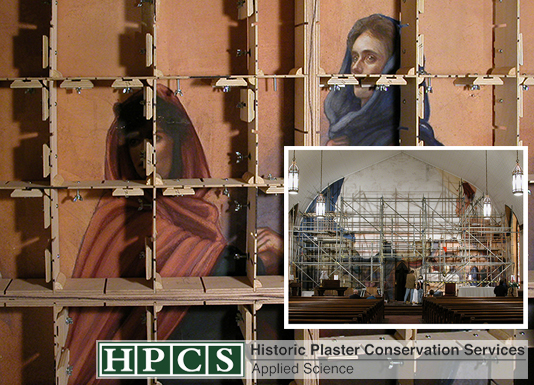St. Peter’s Catholic Church, Charlotte, North Carolina (1893)
The Building:
St. Peter’s Catholic Church, Charlotte, North Carolina.
How to Remove a Precious, Delaminated and Delicate Fresco from a Wall
Seismic shocks from a nearby underground construction project caused approximately 30% of a 1,540 square-foot contemporary fresco, painted by North Carolina artist Ben Long, to collapse. The fresco had been created on a newly applied substrate of lightweight plaster that was about a ½” thick across the board. The fragments, found shoveled into boxes, ranged from gravel and powder to pie plate sized pieces.
The remainder of the fresco was mostly delaminated from its support wall and in very precarious condition when HPCS was invited to evaluate the problem and consider options for its conservation.
The preferred option expressed in our report to the church was to conserve the fresco in situ. This would have been a simple matter of cleaning out debris that had fallen in behind the delaminated blanket of plaster, easing the whole thing back against the wall and holding it there permanently with an appropriate consolidant and adhesive. However, when the artist expressed a disinterest in recreating the portions of the fresco that had been lost, this approach was abandoned.
Gravity allowed the plaster of the salvaged pieces to rest gently on the slides, and each panel was then lifted, maintaining a slight angle away from vertical, up and away from the wall. At a safe distance the panels were rotated to a horizontal position with the slides carrying the weight of plaster. The panels were allowed to rest. The slides were gradually loosened off and the fresco pieces flattened out on their respective panels that also served as the bottom half of the packing crate.

HPCS was asked to develop an alternative option, which was more complex but ultimately very rewarding. It involved connecting specially made 5’ x 10’ egg crate-like panels to standing sections of extremely fragile plaster. The panels had hundreds of sliding plates incorporated into them so that contact could be made with the gently warped plaster surface. The panels were placed close to the wall. After the slides were engaged with the surface, the perimeter of the frame was cut away from the remaining sheet of plaster.

With plenty of padding and a second panel attached, the panels were shipped to the HPCS Studio in Canada where mounting and conservation activities were carried out over several months. Ultimately, 14 individual panels were dispatched back to St. Peter’s where they adorn various parts of the church.


